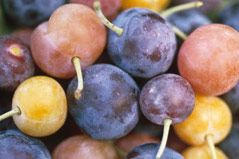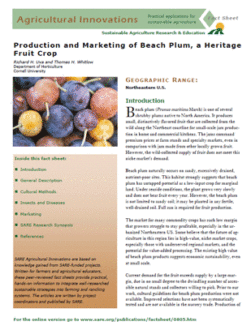Beach plum is still a wild, unimproved species. As with any wild plant grown from seed, its vigor, growth habit and size, and the size and quality of its fruit, vary. Beach plum may grow in a tree like form or as a low, spreading shrub. On sandy soils, the root system is mainly composed of several coarse lateral roots with few fibrous roots. The lateral roots may extend some distance from the main trunk. The plant usually has a large taproot that extends deep into the soil [1].

Leaves are alternate, simple, usually oval-shaped, 1 – 1 1/2 inches long, toothed, dull green above, and lightly hairy or smooth beneath. In mid-May before the leaves emerge, white flowers about three quarters of an inch in diameter appear in clusters of two to five.
The fruit, which ripens from late August through September (4), ranges in size from a half an inch to an inch in diameter. Fruit color varies from red, purple, deep blue, and, rarely, yellow. The plum has a tart taste.
In the wild and under cultivation, biennial bearing has been observed in beach plum. The flowers are seIf sterile and require cross-pollination for good fruit set. It is also thought that closely related bushes within a limited area will not cross-pollinate. Wild honeybees are the most common pollinator, followed by bumblebees, honeybees and syrphid flies [1].
Our approach to beach plum crop development has been focused on two main areas: developing cultural methods for orchard production and marketing the crop and products.
